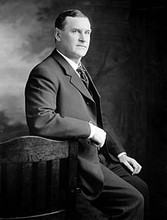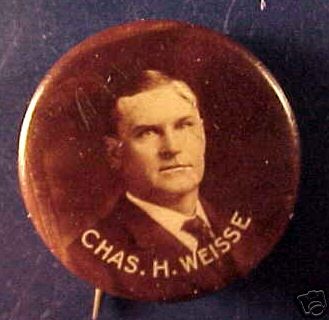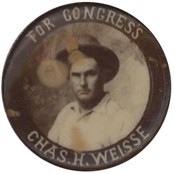Charles Herman Weisse
Introduction
Text-to-speech Audio
Charles Herman Weisse was an important businessman in Sheboygan Falls. He was instrumental in running the Weisse Company, which manufactured leather. Weisse served as a Congressman for a number of years, as well as participating in local politics. In 1919 the Weisse Company tannery burned down. Charles was killed in an accident following the fire, and is buried in Sheboygan Falls Cemetery.
Images


.jpg)

Backstory and Context
Text-to-speech Audio
Charles H. Weisse was born in Sheboygan Falls on October 24, 1866 to parents Charles S. and Minnie. Charles attended German Lutheran School, which is now the St. Paul Lutheran School, and later the Sheboygan Falls High School. By the age of 14 he had also entered his father’s tanning business.
In 1897 Charles S. retired and Charles H. and his three brothers took over the tanning business. The business continued to grow, and Weisse products soon became well known throughout the country. The Weisse Company was a major company in Sheboygan Falls, and employed a number of men in the area. It was particularly known to never shut down, even when the economy was bad. The owners were also known to have close relationships with their workers, going so far as to work alongside the workers. Charles himself served as the active head of the company, becoming well known in the leather industry.
In addition to the leather business, Charles also served on various boards, held local political offices such as President of the City Council (1893-1896) and Treasurer for the School Board (1897-1900), and gave charitably to those in need. In 1896 Charles married Lena Kallenberg and the two had one son, Henry.
In 1900 Charles unsuccessfully ran for congress, but was later elected in 1902 before being re-elected three times, serving from March 1903 to March 1911. In addition to serving as a congressman, Charles was selected to serve as a delegate at the National Democratic Conventions in 1904 and 1908. After his time in Congress, Charles returned to local politics and focused his attention back on the Weisse Company, building a new, four story addition to the tannery and a brand new office building.
Business continued to boom until disaster struck in September of 1919. At 3:30am a fire was discovered by a night watchman in the engine room of the Weisse Factory. The flames spread rapidly to the rest of the building, and by 6:00am the only things left standing were the exterior walls of the tannery and the newly built office building.
Volunteer fire departments from Sheboygan Falls and Sheboygan came to help put out the flames, which shot more than 100 feet in the air. Fortunately, there had been heavy rain in the days leading up to the fire, ultimately saving the rest of the city from burning down as well.
Although devastated by the loss of his factory, Charles was determined to rebuild the tannery for the sake of his family and the community. Eight days later, Charles was joined by his brother Otto and 15 other workers. The men went out to inspect and salvage what they could from the remains. While checking on the still intact vats, a gust of wind hit a nearby wall, knocking it over. Six of the men were injured by falling bricks and taken to St. Nicholas Hospital.
Unfortunately, Charles himself was buried by the collapsed wall and died instantly. Another employee was hit by a brick and knocked unconscious. He then fell into one of the large vats and drowned to death.
According to The Sheboygan Press, “while the burning of the large tannery building the other day was a severe loss to the Falls, it was no comparison to the shock of the tragic death of Mr. Weisse.” In the days leading up to Charles’ funeral, many editorials were published that spoke of the loss of the great, “big hearted man.” It was estimated that there were 500 cars at the cemetery for the funeral, an especially impressive number due to the relative newness of automobiles.
The funeral entourage that carried Charles to his final resting place was made up of his employees, including two of the men who were injured in the accident and who still both wore bandages around their heads. Charles was a dedicated Freemason and prominent masons from all over the state attended the funeral. In addition to these prominent men, congressmen, assemblymen, state senators, and other officials also attended this funeral. A sea of flowers was sent in sympathy from individuals, organizations, and companies from across the country, and small clusters of modest flowers were brought by mourning community members.
Charles Weisse was tragically taken from his community, but is remembered for his deep love of his fellow man, his generous heart, and his dedication to political and community service. He was a man who was willing to serve beside the men who worked for him.
Sources
Weisse, Charles Herman, Wisconsin Historical Society. Accessed December 15th, 2023. https://www.wisconsinhistory.org/Records/Article/CS14226.
Weisse, Charles Herman, History, Art & Archives, United States House of Representatives. Accessed December 15th, 2023. https://history.house.gov/People/Detail/23529.
"$15,000 Fire at the Falls." Sheboygan Press (Sheboygan) September 30th, 1919.
"Nelson Co. Is New Owner." The Sheboygan Press (Sheboygan) April 13th, 1927.
"C.H. Weisse Meets Tragic Death." The Sheboygan Press (Sheboygan) October 8th, 1919.
"Thousands Attend Funeral of Late Charles H. Weisse at Sheboygan Falls Sunday." The Sheboygan Press (Sheboygan) October 13th, 1919.
